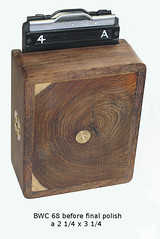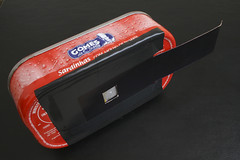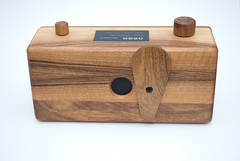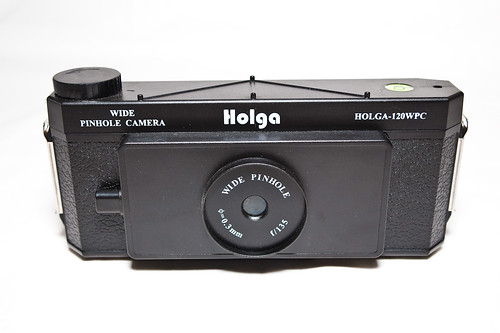Pinhole camera

|
| Handmade pinhole camera, built from Rosewood image by Michael McCoy (Image rights) |
A pinhole camera is the most low-tech, elemental method for creating a photograph. However pinhole cameras' unique image qualities, design flexibility, and minimal cost continue to appeal to photographers even in the 21st century.
Contents
Background

|
| Homemade pinhole camera, built from sardine tin image by Elmo Alves (Image rights) |
The principle of the pinhole camera has been understood since antiquity[1]. If a darkened container admits light only through a single tiny aperture, this effectively projects an upside-down image of the scene outside. If some image-recording medium faces the opening, each point on its image plane can only receive light from a single direction—the one which aligns with the pinhole. Thus, all the areas of light and shadow in the scene can be captured, whether onto film, enlarging paper, or a digital sensor.
Unlike photography using a lens, there is no one defined plane of focus; instead, the image can be recorded at whatever location and scale is preferred. This undefined focus also yields infinite depth of field, although it might be more accurate to say that the entire image is equally unsharp at all distances.
Image effects

|
| Wooden pinhole camera sold by Noon image by perminna (Image rights) |
Makers of pinhole cameras must choose the diameter of the pinhole itself with care. If too large, the image will be quite blurred and show little detail. However this is also true if the pinhole is too small, due to the diffraction of light waves. Thus, an intermediate diameter gives the optimum detail. For cameras of typical dimensions, diameters of 0.2–0.5 mm are used. Naturally this admits very little light, and exposure times may need to be quite lengthy to compensate. However this gives photographers the ability to record moving objects as blurs (or to make them disappear entirely) even in bright sunlight.
Pinhole photographs typically soften fine details, and instead emphasize the large-scale elements of an image: Light & shadow, composition, and the overall form of the subject. This type of abstraction may be a desirable aesthetic effect for some photographers.
Some pinhole designs provide extreme wide-angle coverage, or distortions of perspective caused by a curved image plane. (The iconic "Quaker Oats" pinhole camera is one example.[2] ) A lensed camera offering analogous effects may not exist, or it may be prohibitively expensive. Wide-angle pinhole images typically exhibit dramatic illumination fall-off around their periphery—another aesthetic effect that may suit a photographer's particular vision. And experimental pinhole camera designs can expose multiple overlapping fields of view, or completely transform the geometry of the scene—the options are limited only by the imagination of the camera designer.
Manufactured or homemade
Photographers interested in pinhole images may choose from several pre-made cameras (some are noted in the camera-wiki.org category pinhole). Some of these cameras are works of fine craftsmanship, with price tags to match. Others are educational kits which provide all the materials for construction. Another commercially-offered option is a body-cap pinhole, replacing the interchangeable lens of a conventional camera but leaving all its other functions unaltered.

|
| Holga 120 WPC wide-angle pinhole for 120 film image by Rolf F. (Image rights) |
But pinhole-camera construction is exceptionally forgiving, and complete working cameras can be built from inexpensive or even free materials. Thus, numerous amateur experimenters, craftspeople, impoverished students, or fine artists have chosen to create their own pinhole cameras, or to convert a conventional camera into a pinhole version.
Several possibilities for home-built pinhole designs are discussed in the article homemade pinhole camera.
Commercial pinhole cameras
(List is incomplete)
- 4M pinhole camera (snap-together educational kit)
- Dirkon (folded-paper pinhole camera; see the similar P-Sharan SQ-35)
- Gakken (plastic pinhole cameras in kit form)
- 120WPC pinhole from Holga
- Eastman Pinhole Camera cardboard camera kit
- "Merlin" pinhole camera (paint-can cameras)
- Noon (wooden-bodied pinhole cameras)
- Zero Image (wooden-bodied pinhole cameras)
Commercial pinhole adapters
Commercially made pinhole adapters are a common way of converting conventional interchangeable lens cameras for pinhole photography. Typically the adapter is a body cap with a pinhole that takes the place of a lens. A wide variety of body cap adapters can be found on auction websites such as eBay[3].
(List is incomplete)
- Finney Lochblende pinhole adapters for Canon, Nikon, Leica, and Hasselblad[4]
- Lenox Laser precision pinhole adapters f67-500[5]
- Lensbaby Pinhole/Zone Plate[6]
- Rising Pinhole f131-227 adapters for film and digital cameras
- Skink Pinhole Pancake for Micro 4/3 and DSLR cameras[7]
Special pinhole cameras
Pinhole cameras have been constructed at all different sizes. One quirky project is to build a camera so small it can be held inside the mouth; the photographer's own lips then form the "shutter."[8] The current record holder for the world's largest pinhole camera is one built in a disused fighter-plane hangar at the former El Toro Marine Corps Air Station, in Orange County, California. This exposed an image whose dimensions were 9.6 x 33.8 meters (31.6 x 111 feet)[9].
Notes and references

|
| Improvised "body cap" pinhole using Minolta XD-11 image by Kenneth Dwain Harrelson (Image rights) |
- ↑ Early writings about pinhole images at Wikipedia.
- ↑ "Making Oatmeal Box Pinhole Cameras" by Stewart Lewis Woodruff
- ↑ eBay search for pinhole adapters
- ↑ Finney Lochblende pinhole adapters (archived)
- ↑ Lenox Laser pinhole adapters
- ↑ Lensbaby pinhole adapter (archived)
- ↑ Skink Pinhole Pancake
- ↑ Examples from Flickr here and here.
- ↑ The Legacy Project (The airplane-hangar pinhole camera, and its record-breaking image.)
Bibliography
- Quinnell, Justin and Buczynski, Josh. Build Your Own Paper Cameras. Lewes (UK): Ilex Press, 2009. 96 pages. ISBN 978-1-905814-62-6.
Links
- Examples of pinhole photography at Flickr's largest pinhole pool (several others exist)
- Worldwide Pinhole Photography Day and its Flickr group (An annual celebration of pinhole photography, the last Sunday in April each year.)
- pinhole FAQ by Guillermo Peñate and others
- f295.org site and discussion forums (archived)
- Pinhole cameras and pinhole links in Gabriel Lacomba's pinhole photography site
- Jon Grepstad's history of pinhole photography
- Chart and formula for calculating pinhole diameter, focal length, and aperture